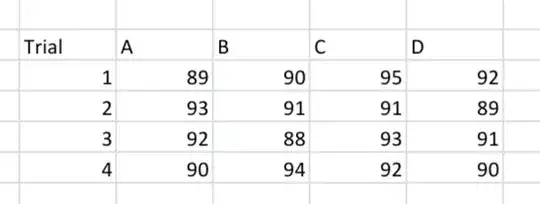This is the data set

How can I determine if this 4 groups differed significantly in their performance

How can I determine if this 4 groups differed significantly in their performance
Do.
Not.
Use.
Unless you want:
How can I determine if this 4 groups differed significantly in their performance
Based on the stripplot of your data below, I had two thoughts:
But for what it is worth, an ANOVA of your data had an $F=1.176$ and $p=0.3510$. Under the usual confidence limit of $\alpha=0.05$, one would consider there to not be a significant difference among your groups.
If I interpret your table correctly, you have one predictor (inpendent variable) which is the category (or group) A-D, and one response (dependent variable) that is the score value in the table and is measured on different independent trials.
In this situation, there are two standard statistical tests that try to answer different questions:
ANOVA automatically takes care of the multiple testing problem, while KS only compares a single pair.